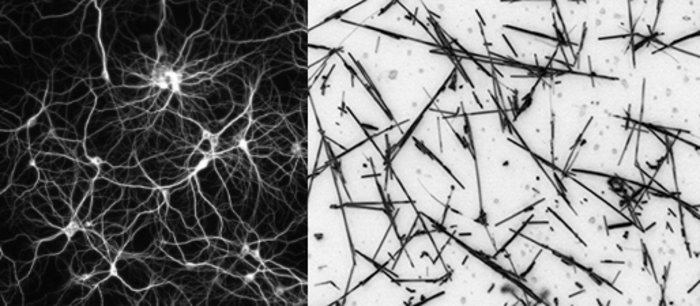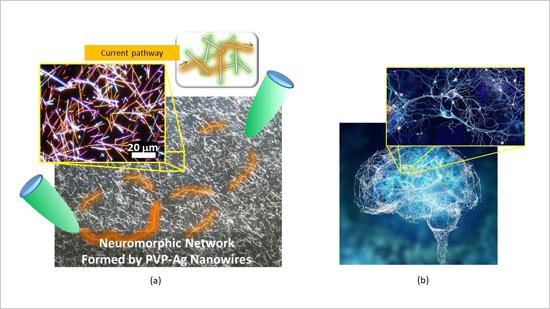It’s all about memory in this April 21, 2023 news item on Nanowerk, Note: A link has been removed,
An international team led by scientists at the University of Sydney has demonstrated nanowire networks can exhibit both short- and long-term memory like the human brain.
The research has been published today in the journal Science Advances (“Neuromorphic learning, working memory, and metaplasticity in nanowire networks”), led by Dr Alon Loeffler, who received his PhD in the School of Physics, with collaborators in Japan.
…
An April 24, 2023 University of Sydney (Australia) press release (also on EurekAlert but published April 21, 2023), which originated news item, offers more detail about the research,
“In this research we found higher-order cognitive function, which we normally associate with the human brain, can be emulated in non-biological hardware,” Dr Loeffler said.
“This work builds on our previous research in which we showed how nanotechnology could be used to build a brain-inspired electrical device with neural network-like circuitry and synapse-like signalling.
“Our current work paves the way towards replicating brain-like learning and memory in non-biological hardware systems and suggests that the underlying nature of brain-like intelligence may be physical.”
Nanowire networks are a type of nanotechnology typically made from tiny, highly conductive silver wires that are invisible to the naked eye, covered in a plastic material, which are scattered across each other like a mesh. The wires mimic aspects of the networked physical structure of a human brain.
Advances in nanowire networks could herald many real-world applications, such as improving robotics or sensor devices that need to make quick decisions in unpredictable environments.
“This nanowire network is like a synthetic neural network because the nanowires act like neurons, and the places where they connect with each other are analogous to synapses,” senior author Professor Zdenka Kuncic, from the School of Physics, said.
“Instead of implementing some kind of machine learning task, in this study Dr Loeffler has actually taken it one step further and tried to demonstrate that nanowire networks exhibit some kind of cognitive function.”
To test the capabilities of the nanowire network, the researchers gave it a test similar to a common memory task used in human psychology experiments, called the N-Back task.
For a person, the N-Back task might involve remembering a specific picture of a cat from a series of feline images presented in a sequence. An N-Back score of 7, the average for people, indicates the person can recognise the same image that appeared seven steps back.
When applied to the nanowire network, the researchers found it could ‘remember’ a desired endpoint in an electric circuit seven steps back, meaning a score of 7 in an N-Back test.
“What we did here is manipulate the voltages of the end electrodes to force the pathways to change, rather than letting the network just do its own thing. We forced the pathways to go where we wanted them to go,” Dr Loeffler said.
“When we implement that, its memory had much higher accuracy and didn’t really decrease over time, suggesting that we’ve found a way to strengthen the pathways to push them towards where we want them, and then the network remembers it.
“Neuroscientists think this is how the brain works, certain synaptic connections strengthen while others weaken, and that’s thought to be how we preferentially remember some things, how we learn and so on.”
The researchers said when the nanowire network is constantly reinforced, it reaches a point where that reinforcement is no longer needed because the information is consolidated into memory.
“It’s kind of like the difference between long-term memory and short-term memory in our brains,” Professor Kuncic said.
“If we want to remember something for a long period of time, we really need to keep training our brains to consolidate that, otherwise it just kind of fades away over time.
“One task showed that the nanowire network can store up to seven items in memory at substantially higher than chance levels without reinforcement training and near-perfect accuracy with reinforcement training.”
…
COI [Conflict of Interest] Statement
Professor Zdenka Kuncic is with Emergentia [can be found here], Inc. The authors declare that they have no other competing interests.

I have a link to and citation for the paper in Science Advances (another link and citation follows),
Neuromorphic learning, working memory, and metaplasticity in nanowire networks by Alon Loeffler, Adrian Diaz-Alvarez, Ruomin Zhu, Natesh Ganesh, James M. Shine, Tomonobu Nakayama, and Zdenka Kuncic. Science Advances 21 Apr 2023 Vol 9, Issue 16 DOI: 10.1126/sciadv.adg3289
This paper is open access.
Never having seen this organization’s (Zenodo.org) setup before I’m a little confused by it,
Neuromorphic Learning, Working Memory and Metaplasticity in Nanowire Networks by Loeffler, Alon; Diaz-Alvarez, Adrian; Zhu, Ruomin; Ganesh, Natesh; Shine, James. M; Nakayama, Tomonobu; Kuncic, Zdenka, https://zenodo.org/record/7633958#.ZEv_2EnMKpo Published: February 12, 2023
I’m not sure if they’re including an early version of the article (I don’t think so) but they do have other files, which are open access and they reference the Science Advances study published in April 2023.
It seems their focus is data, from the About Zenodo webpage,
…
Every last detail
To fully understand and reproduce research performed by others, it is necessary to have all the details. In the digital age, that means all the digital artefacts, which are all welcomed in Zenodo.
To be an effective catch-all, that eliminates barriers to adopting data sharing practices, Zenodo does not impose any requirements on format, size, access restrictions or licence. Quite literally we wish there to be no reason for researchers not to share!
Data, software and other artefacts in support of publications may be the core, but equally welcome are the materials associated with the conferences, projects or the institutions themselves, all of which are necessary to understand the scholarly process.
Don’t wait until the publication date!
Publication may happen months or years after completion of the research, so collecting together all the research artefacts at that stage to publish openly is often challenging. Zenodo therefore offers the possibility to house closed and restricted content, so that artefacts can be captured and stored safely whilst the research is ongoing, such that nothing is missing when they are openly shared later in the research workflow.
Additionally, to help publishing, research materials for the review process can be safely uploaded to Zenodo in restricted records and then protected links can be shared with the reviewers. Content can also be embargoed and automatically opened when the associated paper is published.
To support all these use cases, the simple web interface is supplemented by a rich API which allows third party tools and services to use Zenodo as a backend in their workflow.
…
